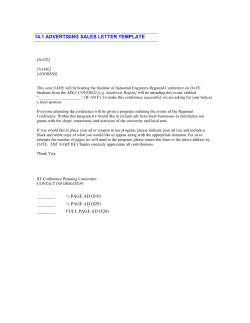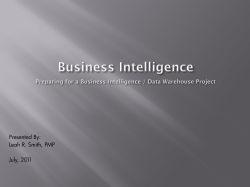
How to build an Information Management Strategy for an Organization?
How to build an Information Management Strategy for an Organization? Pankaj Bhawnani AIIM Western Canada Chapter September 25, 2009 Objectives & Agenda What is Enterprise Information? Why the need for an IM Strategy? Key Elements of an IM strategy A Framework/Approach for creating an IM strategy 2 What is Enterprise Information? Structured data Unstructured data 25% 5% 70% Semi-structured data Information is estimated to double every 11 hours by 2011 The need for IM Strategy? 4 Key Drivers for an IM Strategy – Business Drivers 52% of users don’t have confidence 59% of managers miss information 42% of managers use wrong information in their information1 they should have used2 at least once a week2 2Accenture 1AIIM 2008 Survey 2007 Managers Survey Volume & Variety - We’re Drowning In Information • • • • • • Every second the world creates 390 GB of data 7.5% of documents are lost forever 10% of Canadian Government’s electronic records are not available Average cost of recreating just 20mb of data is $64,000 Viking Space probes cost $1billion and now their magnetic tapes are unreadable – NASA tracked down old printouts and retyped everything Nine ofSTRUCTURED out of 10 organizations will fail in the first year unless they approach information management in a coordinated way (Gartner 2007) UNSTRUCTURED What’s the problem with Information Silos? Information Managers launch RM and eDiscovery initiatives targeting repositories of certain types but ignores the content of others ..while risk analysts build a BI platform to reconcile financial data ignoring other types of Master Data which lies all across the organization The Chief Risk Officer spearheads GRC initiative to drive new policies without taking account the above 2 – hence not seeing the complete picture of risks At one end Chief Legal officer wants everyone to manage information in a centralized & consistent manner, the IT group rolls out SharePoint teamsites with no governance anyone can have any number of sites Everyone is allowed to put content whichever way they choose 7 Information as a Strategic Asset Many organizations still believe that they need to manage information because of Compliance & Legal reasons……. 8 Information as a Strategic Asset Many organizations still believe that they need to manage information because of Compliance & Legal reasons……. 9 Strategic Business Imperatives should drive IM investments These Vary by Industry… Banking Retail …deliver better visibility into financial risk …enable more dynamic demand planning Insurance …increase customer profitability Manufacturing …drive manufacturing efficiencies Healthcare Telco …improve customer experience …address risk & compliance requirements Government …enable more agile government services Trusted Information for the Enterprise has to evolve to support business transformation Business Standards Business Value User Adoption User Adoption Access Processes Biz Business Standards Biz Biz Biz IT BI COE IT BPX Processing Fast & Agile EIM COE EIM Infrastructure IT IT Time System Focused 1990+ Department Focused Enterprise Focused 2000+ Process Focused (intra- / inter enterprise) 2010+ Market Leaders Optimizing Business with Information Understanding 3 million members & 630,000 providers Understanding needs of 20 million customers 10,000 branches serving 125+ million customers 50 brands worldwide Growth in 12 Asian countries Moving from policy based to customer centric after merger Improved provider satisfaction to over 90% Improved sales responsiveness for #1 market share Reduced time to spot new trends from 7 weeks to 7 seconds Increased daily deliveries by 100% Improved customer satisfaction and drove cross-selling eDiscovery & Retention Management – Yes, the cost of Non-Compliance is very high Federal rules of Civil Procedure Keep Everything? Each Gigabyte of Data = ~ 65,000 pages of information Assume each document to be reviewed is 10 pages One attorney can scan/review/code 300 documents per day 65,000/3,000 = 22 days or 176 hrs per gigabyte of data Assume contracting attorney for discovery review is $250/hr. $250 x 176 = $44,000 per GB Standard litigation has 50 -100 GB of data to review = $2.2 $4.4 million 16 Key Drivers for an IM Strategy – Technology Web 2.0 Cloud Computing Data warehouse appliances Information as a service Massive information coming from smart devices Forrester, 2009 Key Elements of an IM Strategy Senior executive sponsorship & cross-organizational involvement Information Management Strategy Reference Architecture 18 Senior Executive Sponsorship & crossorganizational involvement Senior executive sponsorship & crossorganizational involvement Information Management Strategy • Senior executives must champion and drive the IM strategy • IM is everyone’s responsibility so crossorganizational involvement is key – recruiting change agents Reference Architecture 19 Align & Prioritize with Strategic Business Goals Senior executive sponsorship & crossorganizational involvement • Information Management Strategy Reference Architecture • You must highlight how each IM initiative supports: • Top-line revenue growth • Efficiencies that deliver bottom-line savings • Compliance that reduces regulatory risks & • Strategic efforts that contribute to organization’s long-term vision Prioritized and have a phased approach for execution 20 Organizational Change Management Senior executive sponsorship & crossorganizational involvement Information Management Strategy Reference Architecture • Establishing a sense of urgency • Creating a change team with change agents • Developing a vision and strategy for communicating the change • Empowering Broad based action • Generating short-term wins • Consolidating gains and producing more change • Rewarding, recognizing & championing the benefits to the organization from change 21 Governance Senior executive sponsorship & crossorganizational involvement Information Management Strategy Reference Architecture • Embed data and content governance into your business culture • Policies, Procedures and Guidelines • Stewardship both in Business and IT • Information Lifecycle Management • Information Standards (ECM, MDM, Metadata, Taxonomy, Data Quality etc.) • Technology Standards • Audit Frameworks • Roles and Responsibilities 22 Include all Information Types Senior executive sponsorship & crossorganizational involvement Information Management Strategy Reference Architecture • Process, policies, guidelines, technologies and architectures for Use a phased • Documents approach. and/or records High risk/high • Web content value first • Rich media • Databases • Data Warehouses/ Data Marts • Email • IM, Blogs, Wikis… etc 23 Reference Architecture Senior executive sponsorship & crossorganizational involvement Financial Workforce Dynamic Customer & Product Risk Insight Optimization Supply Chain Multi-Channel Marketing Profitability Business Optimization Information Management Strategy Better Business Outcomes Optimize business performance Reference Architecture Establish, Govern, and Deliver Trusted Information Business Optimization Flexible Architecture for Leveraging Existing Investments Other Information Sources Optimize content-based Operational & Compliance Processes Manage Data over its lifetime 24 Accelerating Your Journey to Business Optimization Business Value 5X more value realized by organizations using information effectively Maturity of Information Use Framework/Approach for creating IM Strategy 5 Distinct Stages Align Benchmark Define Prioritize Roadmap IM Strategy Framework – Stage 1 Align Benchmark Define Prioritize Roadmap Align • Align with Corporate Goals •Align with Business Priorities of the Organization •Find the connection •Talk the talk of the business & “C” level executives •Get Buy-in that this is worth doing • How do we do that? Top Down Illustrative Only The IM Journey – Strategy Map MP Information Management Strategy “Improve productivity and reduce costs by providing timely, secure access to accurate information and at the same time reducing the risk of non-compliance by improved management of records” Support Growth Strategy Reduce Operational Cost Improved Company Reputation & Growth Realize Operational Excellence Support Enbridge Operational Excellence Reduce the Risk of NonCompliance Helps Reduce Construction Schedule & Cost Variance Improve Group Productivity Users Adopting and Benefitting from IM Project Stakeholder & Customer Perspective Step 4: Realize benefits • • • • Reduced cost Reduced risk of non-compliance Improve group productivity Increased company reputation & growth Step 3: Focus on business impact as a means to maximizing user adoption & compliance • IM as beneficial to organization’s business Internal Perspective Provide the Right Processes & Systems for IM & Continuously Measure to use, standard IM processes & systems User Information Acquisition & Retention Create Capability & Motivation Step 2: Implement & measure easy • Users capturing & managing information in a common, compliant manner Learning Perspective Step 1: Create organizational IM capability & motivation Establish the Value of IM Provide Access to Process, Tools & knowledge Establish Governance & Stewardship Align Performance Goals • What is IM and why is it important? • What is available to help me do IM? • Establish decision & standards bodies 29 IM Strategy Framework – Stage 2 Align Benchmark Define Prioritize Roadmap Benchmark •Conduct a current state assessment •Refer to standard maturity models such as Gartner •Clearly identify weaknesses and strengths •Point out “liabilities”, “risks” & “opportunities lost” • How do we do that? Illustrative Only Current State • Low awareness of basic IM concepts, roles or responsibilities • Emerging policies and supporting systems – not well socialized • Inconsistent and costly information turnover (‘capture and transition whatever we can’) • Inter-group collaboration via disjointed, laborious means • Significant time and money spent searching for and recreating information • Legal & regulatory risk extremely high 31 IM Maturity at the Organization 32 IM Strategy Framework – Stage 3 Align Benchmark Define Prioritize Roadmap Define a Future State & KPIs •Clearly define what does success mean in bigger picture and not individual projects •Have bigger picture but execute pragmatically •You cannot turn everything “Green” •IM is a journey so make sound investments • How do we do that? Example of driving KPIs Performance Driver • Reduced risk of non-compliance • Improved group productivity • Operational cost reduction Metrics 1. Improved Group Productivity • 2. Reduce risk of non-compliance • • Compliance audits Reduced spending on outside counsel in litigations 3. Operational Cost Reduction • • Improved company reputation & growth Response time improvement for process optimizations e.g. faster response to customer calls, faster processing of insurance claims etc. • Improved project variances due to information findability % of time reduction re: having to recreate lost or damaged artifacts 4. Improved Company Reputation & Growth • • % of initiatives completing on time and within budget BI Dashboard resulting in reduced response time 34 in opportunity assessments IM Strategy Framework – Stage 4 Align Benchmark Define Prioritize Roadmap Prioritize •Prioritize all opportunities to best align with business problems •Quantify Value & Benefits •Create a Benefits Delivery Strategy •Transparent decision making in selecting priorities • How do we do that? Prioritization & what-if analysis – Business View Note that position along the Contribution axis is driven by the four success factors listed below. The weightings of these factors are as follows. Establish IM Governance Body/Council Scanning & OCR for MP Low Prioritization of Information Management Initiatives Policy Procedures (RM, Document Control, Email) Screening & Planning BPA Information Re-purposing Information Architecture & Metadata Model BPM for MP checkpoints Constuct BPA 1.00 Reduce Operational Cost 1.00 Improve Group Productivity 0.50 Improve Company Reputation 0.25 LEGEND BPM for Turnover to LP Cost Design & Proc. BPA Reduce Risk of NonCompliance Improve Productivity Reduce Risk Improve Reputation Reduce Cost Change Level Required Master Data Identification & Management standards =High contribution =Medium contribution GIS System Integration Email Management Low High Implement electronic/physical archiving solution SP & LL Integration High Contribution to Success Factors =Low contribution =Low Change Level =High Change Level 36 IM Strategy Framework – Stage 5 Align Benchmark Define Prioritize Roadmap Roadmap & Action Plan •Roadmap should reflect all business priorities •Create a roadmap to encompass work related to all key elements (6) •Clearly reflect where do we end up •Clear timelines for benefits delivery • How do we do that? Timeline – Illustrative Only Roadmap Summary by Workstream 38 IM Maturity Impacts – IM view Initiative Impact on Information Management Maturity BPM for Turnover to LP Master Data Management 20 18 Scanning & OCR for MP 16 Archiving Solution 14 SP & LL Integration 12 10 8 GIS System Integration IM Governance & Council 6 4 2 0 Construct BPA Policy & Procedures Design & Proc. BPA Screening & Planning BPM Email Management IA & Metadata Model Information Repurposing BPM for Checkpoints 39 Where Do We End Up? End of 2012: • Costs of Litigation reduced • Risk of non-compliance reduced • Business Optimization achieved with Data Marts • Executive sponsored awareness of IM concepts, roles and responsibilities • Well socialized, businessdriven policies and supporting systems • Consistent and efficient information management/turnover • Effective inter-group collaboration through secure areas 40 Business Value Delivered and Organizational Capability Improved for sustained IM 41 Questions? Thank You Pankaj Bhawnani p_bhawnani@yahoo.com pankaj.bhawnani@c3associates.com Blogs http://pbhawnani.blogspot.com/ http://whyinformationmanagement.blogspot.com
© Copyright 2025














